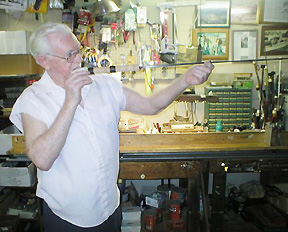Chesapeake Bay's Independent Newspaper ~ Since 1993
1629 Forest Drive, Annapolis, MD 21403 ~ 410-626-9888
Volume xviii, Issue 27 ~ July 8 - July 15, 2010
Home \\ Correspondence \\ from the Editor \\ Submit a Letter \\ Classifieds \\ Contact Us
Best of the Bay \\ Dining Guide \\ Home & Garden Guide \\ Archives \\ Distribution \\ Advertising![]()


Making the Grade
Rod maker George Pavlik had agonized over this rod —
the perfect stick for casting to white perch
My skiff had drifted a good distance from the cove’s rip-rapped edge by the time I glimpsed the slight flash. It was the gold/green hue of a big white perch, deep and near the rocks. Arcing my spinner bait out over the growing distance, I got it close to the mark.
|
I gave the lure just a second or two to get down, then started to crank. The fish must have hit it on the drop, because I was immediately solid. It felt like a good one.
Playing it gently, I kept a good bend in the long, light-action rod. The lively slender stick dipped, then bowed deeply with each run as the obviously husky devil sought escape, first one way, than another. The slightly set drag on my spin reel buzzed as I let the fish run and run again, patiently wearing it down.
The perch stayed deep for the longest time, a sure sign of a good-sized whitey. It came to the surface only when it had finally spent the last of its energy. As I eased the thick, dark perch closer, I could clearly see the spinner bait barely connected to its mouth. A thin, white string of tissue was all that still held it.
My lure broke free just as I slid the net under the hefty rascal, and with a sigh of relief I brought it on board. Almost all of the fish I landed that morning had been lightly hooked, and I had lost a number of big ones despite my gentlest efforts. Some days they just strike short, and you have to deal with it.
Getting It Right
This was the maiden run for a new custom rod, and it was turning out to be all that I had hoped. It was long for a perch rod, six-foot nine-inches, and of a particularly lightweight and sensitive graphite by St. Croix. A lovely 12-inch Tennessee-style handle and extra slick Fuji silicone carbide guides completed the package.
Friend and local rod maker George Pavlik and I had spent the past winter agonizing over the details of this rod, which was intended to be the perfect stick for casting specifically to white perch with light spinner baits. It looked like we had designed a winner.
I had wanted a long rod that would cast good distances. I also wanted it comfortable in the hand, with an action that wouldn’t wear me out over a long day, and also soft enough to protect a hook set in the thin tissue of a big perch’s mouth.
George had offered to build it for me, and I had jumped at the opportunity. A custom-made rod is really not much more expensive than one bought off the rack. And when you’re as particular as I am about the features of your fishing tools, it can mean getting just what you want versus getting one that will just do.
A Tennessee-style handle, a simple cylinder of cork with sliding rings to hold the reel, was a particular desire. Back in the day, it was not called a Tennessee handle, for it was the only style made. Only years later did up-locking and down-locking metal and graphite reel seats become popular.
This later high-tech construction is certainly more efficient in holding reels firmly and in perfect alignment on your rod. But I much prefer the warm, comfortable feel of cork under my hand to the feel of plastic and metal. Anglers from the state of Tennessee apparently hold this preference, too, as this style of handle is now named for their state.
George brought 40 years of rod-making experience to adding what else was needed in a quality instrument, features such as accurately determining rod spline.
Because of the way rod blanks (or rod tubes) are made, they invariably tend to bend more easily along one axis of the rod’s length. Aligning and spacing the guides precisely along this axis ensures a uniform flex in the casting motion. Not all manufacturers go to the trouble and expense of splining the blank.
I dithered for almost the entire winter over every detail of the rod, but it took George just a week or so to execute the final product. It was beautiful.
The rod is comfortable to my hand and accurate to cast. It can throw long distances, and its action is distributed over its length, making it effortless to throw and superb for fighting the delicate-mouthed white perch. It also has the reserve power nearer the butt to allow me (though just barely) to tangle with the occasional five-pound rockfish that may decide to brighten my day.
If you want to spoil yourself (or someone else) on some special occasion, a custom-made rod may be just the thing. It will bring years of pleasure and satisfaction.
For custom rods and repairs: George Pavlik at George’s Rod Shop: 410-255-2540.
Fish Are Biting
The extreme heat wave and other unsettling weather patterns have disrupted the rockfish bite, with the fish indecisive and constantly moving about. Trolling is probably the best method for locating and boating a few fish, though be sure to drag smaller baits. Spot sized for live-lining, also have been hard to find and the rockfish unusually selective. If you don’t have properly sized spot (usually three to five inches) the stripers won’t eat; small perch baits have been almost totally ignored. The croaker bite, however, is still on, particularly in the evening, and white perch, when they can be found, have often been quite large. Crabbing continues beyond excellent, and the critters are just getting bigger and fatter.
© COPYRIGHT 2010 by New Bay Enterprises, Inc. All rights reserved.

 While I dithered almost all winter over every detail of the rod, it took George just a week or so to execute the final product. It was beautiful.
While I dithered almost all winter over every detail of the rod, it took George just a week or so to execute the final product. It was beautiful.